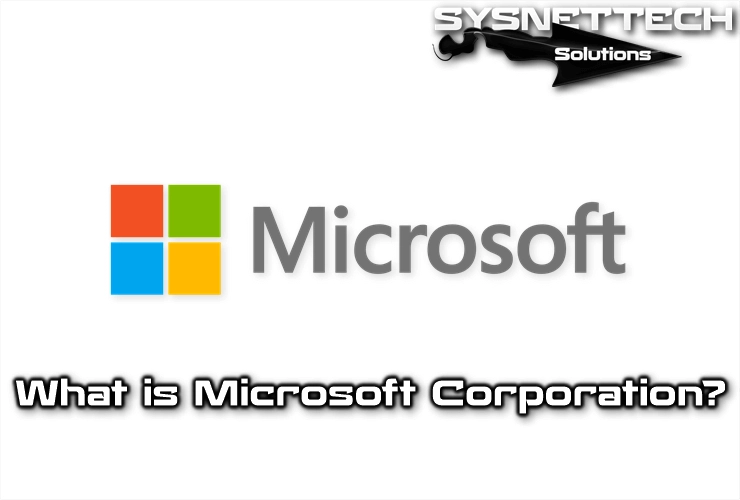Microsoft Corporation is a computer company founded in 1975 by Bill Gates and Paul Allen. The company, which develops, produces, and licenses software and electronic equipment, is headquartered in Redmond, Washington, USA.

What is Microsoft? Information About Its Establishment, History, and Company
The most used products are the Windows operating system and Microsoft Office application, both of which have an essential position in the computer world.
History
Microsoft’s history is fraught with attitudes that are illegal in some cases. It has faced numerous judicial convictions in various countries; for example, in 2004, the European Union fined approximately 500 million euros for anti-competitive practices in abusing its monopolistic position.
Microsoft (MS) was founded on April 4, 1975, when Bill Gates and Paul Allen were students at Harvard University.
Altair 8800, the first personal computer, was featured on the cover and article of Popular Electronics magazine.
Bill Gates contacted the founders of the new microcomputer, Micro Instrumentation and Telemetry Systems (MITS), and submitted a proposal for the implementation of the BASIC programming language for the system. Later, MITS agreed to distribute Altair BASIC.
Gates left the university to accept 50% of computer sales in computer language and then moved to Altair’s headquarters in Albuquerque and founded Microsoft.
The company’s first international Office was open. The Office had great enthusiasm under the name ASCII Microsoft in Japan on November 1, 1978. Later, on January 1, 1979, Microsoft Corporation moved to Bellevue, Washington.
On June 11, 1980, Steve Ballmer joined the company and was to replace Bill Gates as CEO of Microsoft.
After the establishment of the company, Microsoft would be the first to offer products other than BASIC, COBOL, and Fortran compilers. The company’s first operating system was a variant of Unix in 1979.
Acquired under a distribution license from AT&T, Microsoft hired Santa Cruz Operation to develop the OS for significant platforms, renamed Xenix.
Xenix was temporarily awarded to Santa Cruz Operation in 1985, which developed the 80286 microprocessor system under the name SCO UNIX.
In 1980, Bill Gates met with IBM representatives in Seattle and sold the DOS, although it was not yet developed. He signed an agreement with IBM to distribute the MS-DOS operating system under the name PC-DOS.
This system, formerly called Q-DOS, was purchased by Microsoft from Seattle Computer Products for $50,000. However, the lawsuit was filed due to a confidential agreement with IBM at the time of purchase.
IBM signed a contract for redistribution by not buying MS-DOS from Microsoft. With the introduction of Microsoft Mouse in 1983, the company stepped into new markets.
Microsoft Company Structure
The company is managed by a Board of Directors consisting of approximately ten people. Current board members are Steve Ballmer, James Cash, Dina Dublon, Bill Gates, Raymond Gilmartin, Reed Hastings, David Marquardt, Charles Noski, Helmut Panke, and Jon Shirley.
Ten members of the Board of Directors are elected at the shareholders’ meeting every year, and those who do not obtain the majority of votes must resign from the Board of Directors.
In addition, five committees on the board of directors supervise more specific issues.
Please take note of the following information:
The company has several committees, each with specific responsibilities:
- Audit Committee: Deals with accounting issues, audits, and reporting.
- Compensation Committee: Approves compensation for the president and employees.
- Finance Committee: Handles financial matters, including merger proposals.
- Appointments and Governance Committee: Addresses various company issues.
- Antimonopoly Compliance Committee: Works to prevent the company from violating antitrust laws.
The company also has an executive team for global relations, consisting of sixteen company officials who are responsible for various functions.
There is the Corporate Staff Council, which addresses all the essential functions of company staff, including the approval of company policies. Other executives can be classified as Heads and Vice-Presidents of different product divisions, leaders of the marketing division, and IT Managers.
Microsoft Windows
Microsoft Windows was released in August 1985, but it was not stable until 1990. It became the first wide diffusion graphic medium in computers compatible with IBM-PC.
From a technical point of view, it did not offer any innovations as there are similar environments of much higher quality.
A clear example was given by the Apple company in the 1970s. In 1989, Microsoft released its main office suite, Microsoft Office, and office applications such as Microsoft Word and Microsoft Excel.
On May 22, 1990, the new version of the OS, a more rational and quality graphical user interface (GUI) and protected mode developed for the Intel 386 processor, was released in Windows 3.0.
In 1993, MS released Windows NT 3.1, an operating system with a Windows 3.1 interface but with a completely different kernel.
Windows 95, a new version of the company’s flagship OS with a completely new user interface in 1995, was among the latest features, including the new Start Menu and improved file explorer, plugin, and Hardware compatibility.
In the same year, a new version of the Internet Explorer web browser system that came with Windows 95 Plus was released.
Initially, there were a lot of errors and problems with Internet Explorer, but over time, these have improved significantly.
On August 24, 1995, it launched its leading online service, MSN (MS Service Network), to compete with AOL (America Online). The MSN service has become Microsoft’s general brand for online services and has widely used users.
In 2009, MS suddenly decided to cancel Messenger service in countries where the U.S. holds a trade embargo.
Among the affected countries were Cuba, Iran, Syria, Sudan, and North Korea, which made it clear that they rejected US policies.
While trying to connect to the MSN service, users started getting error 810003c1, which prevented them from going online.
The US attitude towards Cuba was a commercial, economic, and financial blockade imposed on the island by President John F. Kennedy.
In October 1995, the United States Department of Justice filed a lawsuit stating that it violated an agreement signed in 1994 by the Federal Court and requested that the browser sale not be distributed with Windows due to compelling manufacturers.
In 1998, Bill Gates appointed Steve Ballmer as MS President but continued to chair the company’s Board of Directors.
That year, Windows 98, the new version of Windows, was released. It was an update for Windows 95 with new features and compatibility with new device types.
A year after the release of Windows 98, Windows 98 SE was released. This new system was not an update for Windows 98. It was a completely new product.
By fixing the bugs of previous versions, Windows 98 SE expanded its compatibility with peripherals and Windows NT, providing more excellent stability and the ability to share an Internet connection over the local network.
By court order, Microsoft had to sell a version of this operating system that did not include Internet Explorer in some regions where this was not allowed in the previous version of Windows.
On February 17, 2000, Windows 2000 added, among its innovations, the Active Directory feature, which allows organizations to work globally with all their machines, including Device Manager and Windows Media Player, and improve Windows NT compatibility.
The Windows 2000 system is designed for professional use, but it has not been widely used for home use and employees.
For these reasons, on October 25, 2001, Microsoft released Windows XP, which provides compatibility for both home and business computers.
However, Windows XP received a lot of criticism for the security flaws that were found, and it is less compatible with devices and some programs.
Microsoft’s new business solution was introduced on April 24, 2003, and a Windows Server 2003 system was developed, which was 150% faster than Windows 2000 Server and 250% faster than Windows NT 4.0.
The company initiated legal action against Microsoft by the European Union due to the dominant market abuse. Microsoft then had to market new versions of the Windows XP system.
These new versions were designed as Home Edition N and Professional N but did not include Media Player.
In 2006, Bill Gates announced the beginning of a transition period, appointed as the Head of Software Architecture, and appointed the position of Ray Ozzie. However, Gates remained chairman of the board and consultant on critical projects.
The company officially launched Windows Vista on January 29, 2007.
A year and a half after Windows Vista, the company’s vice president, Brad Brooks, during a speech at the Worldwide Business Conference, acknowledged many of the significant errors that Windows Vista has only brought up to a point.
As for security issues, Brooks was pleased with the progress made by the operating system, but the first vulnerability was a bad situation before the product was officially released.
In this system, the security warnings that disturbed the user, battery consumption in laptops, and performance degradation when using new features were not evaluated.
Windows 7, 8, 8.1, and Windows 10 are versions of Windows, an OS manufactured by Microsoft for use on PCs, including desktops, laptops, tablet PCs, netbooks, and media center computers in homes and offices.
Agreements Between Yahoo! and Microsoft
On February 1, 2008, Microsoft announced its intention to purchase $44.6 billion in cash and $31 in stock from one of its biggest competitors, Yahoo.
This proposal was made in challenging times for Yahoo, who recently announced that 7% of his company’s layoffs are trying to restructure the company.
Soon after, Yahoo decided not to accept the offer, considering Microsoft’s offer to be largely non-valuable to Yahoo.
Then, Google signed a search cooperation agreement with industry leaders to beat the Microsoft and Yahoo search engine.
The first of the terms of the agreement states that Microsoft will use Yahoo as the default search engine for 1tenyears. The second indicates that during the first five years, 12% of advertising revenues will be transferred to Microsoft on their website.
Yahoo was a macro directory where everyone was looking for websites. However, shortly after starting his development, he decided to outsource the search engine called Google.
With this decision, Yahoo lost the opportunity to develop a search engine that competes with Google.
Lawsuits Against Microsoft
Since 1980, Microsoft has been the subject of controversy in the computer industry.
Microsoft initially produces a standard product and then develops versions of its products that do not meet standards, preventing them from leaving work and using the new version of the product.
These tactics led several companies and governments to file lawsuits against the company.
International software giant Microsoft faced numerous monopoly cases.
The Norwegian company Opera sued, and Mozilla joined the case because the Windows OS did not allow the user to select the desired browser.
The commission accepted the case and filed a lawsuit, but Microsoft’s suggestions were received.
In 2007, the company i4i sued Microsoft for its patent for a document system that eliminated the need to enter format codes manually, and the judge concluded that Bill Gates must pay more than $250 million in cash.
Another of these companies, Symantec, filed a lawsuit against Microsoft. The reason for this is that Windows Vista exposed industrial secrets that had been carried out by the Gates company against Symantec.
Bill Gates’ Largest Opponent
Steve Case is the only person to have met and won Bill Gates in the hi-tech industry. The president of America Online (AOL) defeated Microsoft’s boss with great success.
AOL, the market leader in the United States and Western Europe, and with its ambitious expansion plans in Latin America and Asia, AOL is the world’s most significant Internet power that revolutionizes the way people work, buy, and play.
Other Products of the Company
Although Microsoft is generally known for its Windows and Office software, it has also taken necessary steps in the business world. In addition to these two great products, it also includes some software below;
- Biztalk Server
It provides automation and management of business processes.
- Exchange
It is an e-mail server that includes messaging and calendar services. One of its most important features is its integration with Microsoft Office.
- Internet Security and Acceleration Server (ISA)
It is a corporate, multi-layered, and cache Firewall Server.
- Operations Manager
It enables monitoring of Windows Server systems and .NET applications.
- Sharepoint Portal Server
Integrated into Office provides professional tools for collaboration, content management, and implementation of business processes.
- SQL Server
It is a database platform that offers business data management tools.
- Systems Management Server
It provides system management tools such as remote control and software distribution.
- Microsoft Project
It provides the creation, editing, and management of business projects.
- Security Essentials
It is a free antivirus program, formerly known as Morro.
- Microsoft Works
It provides productivity tools for home users, including a text editor, spreadsheet, database manager, and project planner.
- Microsoft Mobile
It is the operating system for smartphones and PDAs.
- Encarta
It is an electronic encyclopedia that provides service through both a website and a program.
- Microsoft Picture It!
It is a program that provides all the arrangements for photography.
- Microsoft Live
It is an instant messaging program, formerly called Windows MSN.
- Visual Studio
It includes tools such as Visual Basic, Visual C++, Visual C, and Visual J for computer application developers.
- Internet Explorer
The Internet Explorer web browser has Windows, Apple Macintosh, and Solaris Unix versions.
- Xbox/Xbox 360
It is a new generation game console developed by Microsoft.
- Surface
It provides processing of transactions made with hand gestures to digital content.
- Zune
It is a digital music player.



